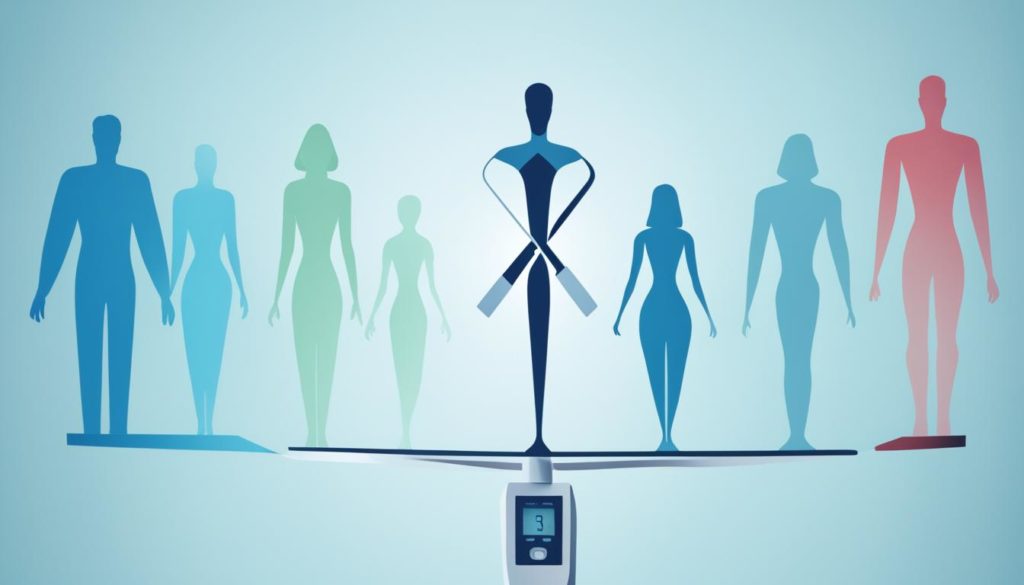Did you know that 88 million American adults have prediabetes? That’s more than 1 in 3 people. Yet, 84% of them don’t know they have it. This fact shows how crucial it is to know about the dangers of insulin resistance and how to prevent high blood sugar.
Prediabetes is what happens before Type 2 diabetes. It means blood sugar levels are higher than normal but not high enough to be labeled as diabetes. Dr. Eleanna De Filippis from Mayo Clinic mentions that being overweight, having a family history of the disease, and belonging to certain ethnic groups can make someone more likely to have insulin resistance.
Most people with prediabetes don’t show any symptoms. It’s usually found during routine check-ups. Doctors look at waist size, blood pressure, and fasting glucose levels to diagnose it. The good news is, with lifestyle changes and sometimes medicine, it’s possible to reverse insulin resistance and get blood sugar back to normal.
Key Takeaways
- Prediabetes affects more than 88 million American adults.
- 84% of individuals with prediabetes are unaware of their condition.
- High blood sugar prevention includes regular screenings and lifestyle changes.
- Risk factors include excess weight, family history, and certain ethnicities.
- Prediabetes can often be reversed with proper management and intervention.
What is Prediabetes?
Prediabetes is when blood sugar levels are higher than normal but not high enough to be diabetes. It’s a sign that insulin in the body isn’t working well. Catching it early is key to stopping diabetes from starting.

Definition and Explanation
Prediabetes is like an early warning. It shows that blood sugar is up, but it’s not diabetes yet. Also called *borderline diabetes*, it can go on for years without signs. Doctors use special tests to find it.
How it Differs from Type 2 Diabetes
Prediabetes and Type 2 diabetes both involve unusual sugar levels. The main difference is how high the sugar is. Prediabetes can be turned around with healthy choices. But, Type 2 diabetes means more serious treatments are needed.
| Parameter | Prediabetes | Type 2 Diabetes |
|---|---|---|
| Blood Sugar Levels | 100-125 mg/dL (fasting) | 126 mg/dL or higher (fasting) |
| Potential for Reversal | High with lifestyle changes | Requires long-term management |
| Insulin Resistance | Present (Glucose Intolerance) | More severe |
| Symptoms | Often asymptomatic | More pronounced |
Causes of Prediabetes
To prevent and manage prediabetes well, we need to understand its causes. Let’s look into the lifestyle and genetic factors that lead to prediabetes.

Genetic Factors
One big reason some people get prediabetes is their genetic predisposition. If your family has a history of Type 2 diabetes, you’re at a higher risk. Being of African, Latino, or Native American descent also ups your chances. These genetic traits affect how your body handles insulin and sugar levels.
Lifestyle Factors
Living an unhealthy lifestyle can also push you towards prediabetes. Bad eating habits, not being active, smoking, and certain medications play a part. Health issues like obstructive sleep apnea and polycystic ovary syndrome (PCOS) can make prediabetes symptoms worse by increasing insulin resistance.
Risks Associated with Prediabetes
People with prediabetes are at significant risk for serious health issues if they don’t manage their condition. It’s very important to know about these risks to take care of your health.
Increased Risk of Type 2 Diabetes
Prediabetes can lead to Type 2 diabetes, especially if you don’t change your lifestyle. Changes like better diet and more exercise are needed. Insulin resistance makes it harder for your body to control blood sugar, which can lead to diabetes.
Cardiovascular Complications
Prediabetes also affects your heart health. It can make your arteries hard, which raises the chance of heart disease. Keeping blood sugar levels in check helps avoid these heart risks.
Other Health Concerns
Prediabetes can cause other issues like nerve damage, bad circulation, and kidney problems. These issues come from high blood sugar hurting your body over time. Fighting insulin resistance with diet and exercise is key to avoiding these problems.
Identifying Symptoms of Prediabetes
Spotting symptoms of prediabetes is tough because they’re usually not obvious. Most times, these signs are hardly noticeable, which makes finding them early hard. Yet, knowing what signs of high blood sugar to look for is key.
Watch for an increase in waist size, as it may signal harmful visceral fat buildup. This fat is known to cause insulin resistance. Skin issues like acanthosis nigricans are also telling. They appear as dark, soft patches in areas where your skin folds.
It’s also smart to keep an eye on fasting glucose numbers. If they’re between 100 and 125 mg/dL, it might mean high sugar levels. An A1C test result between 5.7% and 6.3% also points to a higher diabetes risk.
For simplicity, here’s a quick table outlining key high blood sugar signs:
| Indicator | Threshold |
|---|---|
| Elevated Waist Circumference | Varies by individual, significant increase from normal |
| Skin Conditions (Acanthosis Nigricans) | Dark, velvety patches in body folds and creases |
| Fasting Glucose Levels | 100-125 mg/dL |
| A1C Levels | 5.7%-6.3% |
Being aware of these symptoms is crucial for early detection and action. By keeping track, you can manage and even prevent type 2 diabetes.
Diagnosing Prediabetes
Finding out if someone has prediabetes early on is key to stopping type 2 diabetes. Healthcare professionals use several ways to check if someone is at risk.
Physical Exams and Medical History
Doctors usually begin by examining the patient physically and reviewing their medical past. This helps spot potential signs of insulin not working right and other risk factors. They talk about how the patient lives, their family’s health history, and anything else that could affect blood sugar.
Blood Sugar Tests
Checking blood sugar is important for seeing where it’s at. There are two main tests for prediabetes testing:
- Fasting Glucose Test: This looks at blood sugar after not eating for at least 8 hours.
- Oral Glucose Tolerance Test (OGTT): This checks blood sugar before and after drinking something sugary.
These tests find unusual blood sugar levels that could lead to type 2 diabetes.
A1C Tests
The A1C test is a trusted way for prediabetes testing. It doesn’t just look at the blood sugar at one time. Instead, it shows the average levels over the last few months. This helps patients and doctors get a clear picture of blood sugar control over time.
| Test Method | Purpose | Measurement Frequency |
|---|---|---|
| Physical Exams and Medical History | Identify symptoms and risk factors | Initial Diagnosis |
| Blood Glucose Monitoring | Measure current blood sugar levels | Regularly, as advised |
| A1C Testing | Assess average blood sugar over 2-3 months | Every 3-6 months |
By using these methods, people and their doctors can keep an eye on prediabetes. This helps them stay healthy and lowers their chance of getting type 2 diabetes.
Understanding Insulin Resistance
Insulin resistance is a key factor in developing prediabetes. It’s essential to know what it is and how it affects us.
What is Insulin Resistance?
Insulin resistance happens when our body’s cells don’t react well to insulin. This hormone helps control our blood sugar. If cells don’t respond, the pancreas makes more insulin. This leads to more insulin and sugar in our blood.
Eventually, the pancreas might not make enough insulin. This causes high blood sugar, leading to prediabetes or Type 2 diabetes. Not eating well and not exercising enough can make insulin resistance worse.
Its Role in Prediabetes
Prediabetes and insulin resistance are closely linked. Insulin resistance makes the pancreas work harder to make insulin. Without changes, this can turn into diabetes.
Changing how we live can lower these risks. Eating foods like whole grains, lean proteins, and veggies helps. So does exercising regularly. These steps improve how well our body responds to insulin.
Understanding insulin resistance includes knowing how important it is to act early. Taking steps now can help manage insulin sensitivity. This can prevent moving from prediabetes to diabetes.
Prediabetes (Borderline Diabetes) and Lifestyle Changes
Managing prediabetes effectively often requires incorporating significant lifestyle changes to maintain optimal health and avert progression to type 2 diabetes. This section highlights key areas where lifestyle adjustments can make a marked difference.
Dietary Adjustments
A well-balanced prediabetic diet is crucial for managing blood sugar levels. Emphasizing wholesome foods such as fruits, vegetables, nuts, and lean proteins can help regulate blood glucose. Studies have shown that dietary interventions can significantly reduce the incidence of type 2 diabetes in people with prediabetes. For more insights, visit this comprehensive study exploring the impact of diet on prediabetes.
Importance of Physical Activity
Regular physical activity is key for managing prediabetes. Daily exercises like brisk walking, cycling, or yoga improve insulin sensitivity. Making physical activities enjoyable and sustainable is vital for long-term commitment.
Managing Stress
Stress management is crucial in prediabetes care. Chronic stress can negatively impact blood sugar levels and overall well-being. Techniques such as mindfulness, meditation, and getting enough rest help reduce stress, benefiting both mental and physical health. These strategies contribute to a comprehensive approach to managing prediabetes.
For an in-depth analysis of how lifestyle interventions, including a prediabetic diet, support long-term health, consider the findings presented in this detailed meta-analysis.
Medical Treatments for Prediabetes
Treating prediabetes often starts with big changes in how you live your life. Sometimes, though, medicine is needed to control blood sugar. When this happens, medicines to prevent diabetes become very important.
Prescription Medications
There are many medicines that help with prediabetes. These drugs make the body better at using insulin and lower sugar production in the liver. For example, doctors often prescribe Metformin. It cuts down the sugar your liver puts into your blood. This helps especially if lifestyle changes didn’t work well enough.
Glucophage is another drug that helps your body use insulin better. It’s crucial to talk with a doctor to find the best medicine and dose for you. You can learn more about these treatments at the Mayo Clinic website.
Monitoring Blood Sugar Levels
Checking blood sugar regularly is key to managing prediabetes. This lets health experts see if medicine is working right and make changes if needed. Doing this helps keep sugar levels under control. It also lowers the chance of getting type 2 diabetes.
Below is a table of common prediabetes medicines and what they do:
| Medication | Primary Function |
|---|---|
| Metformin | Lowers glucose production by the liver |
| Glucophage | Improves insulin sensitivity |
Talking with your healthcare team about how to watch and manage your sugar levels is important. This plan should help control prediabetes and cut down the risk of type 2 diabetes. For more help, check out the Mayo Clinic website.
Preventing the Progression to Type 2 Diabetes
Stopping prediabetes from becoming Type 2 diabetes is key. By taking the right steps early, you can cut risks and live healthier.
Early Intervention Strategies
An early prediabetes intervention means watching your blood sugar closely. Change what you eat and move more. Such programs outline the steps for keeping up with these healthy choices.
- Track blood sugar levels consistently
- Adopt a balanced diet low in refined sugars and high in proteins
- Engage in at least 150 minutes of moderate physical activity per week
- Manage stress through mindfulness or relaxation techniques
CDC-recognized Lifestyle Change Programs
The CDC lifestyle change programs are all about stopping Type 2 Diabetes. They give you coaching, friends to support you, and lessons that help you change. Eating better, exercising, and changing behaviors through these programs really helps against diabetes.
| Aspect | Description |
|---|---|
| Dietary Counseling | Expert advice on implementing a nutritious diet tailored to individual needs |
| Activity Plans | Custom exercise routines to maintain blood sugar levels within a normal range |
| Support Groups | Regular meetups with peers facing similar challenges, fostering motivation and accountability |
| Education | In-depth information on the importance of maintaining a healthy lifestyle and its impact on diabetes prevention |
Success Stories and Case Studies
Prediabetes success stories show how lifestyle changes can make a big difference. They inspire those facing similar health problems. By reading these stories, people learn about changing their lives for the better.
Take Frank Hu, a well-known nutrition expert, as an example. He changed his diet and exercised more to control his glucose. His success shows that making simple changes can reverse prediabetes.
The National Diabetes Prevention Program (NDPP) is another excellent example. Run by the CDC, it has helped many people share their success stories. These stories prove that joining structured lifestyle programs can lower diabetes risks.
| Individual | Success Strategy | Outcome |
|---|---|---|
| Frank Hu | Diet and Exercise | Reversed Prediabetes |
| NDPP Participants | CDC Program | Lowered Risk of Type 2 Diabetes |
These stories offer hope and act as real-life guides. They show that prediabetes can be reversed, not leading to diabetes. It proves that taking action can lead to better health.
Conclusion
Prediabetes is a condition we need to understand well. Knowing about it can greatly affect our health. To avoid moving on to type 2 diabetes, we need good plans for handling prediabetes. These include eating better, staying active, and keeping stress in check.
It’s key to spot prediabetes early and start taking care of it right away. Advice from doctors and using certain medicines can be super important. By keeping track of our blood sugar, we can also dodge problems with our heart and more.
To wrap up, making smart choices and following doctors’ advice can greatly help. This way, folks can keep their health in check and avoid diabetes. Being ahead of the game by leading a healthy lifestyle is the way to go for living well with prediabetes.
FAQ
What is prediabetes?
Prediabetes means your blood sugar is high, but not high enough for Type 2 diabetes. It can lead to diabetes but lifestyle changes might reverse it.
How does prediabetes differ from Type 2 diabetes?
Prediabetes and Type 2 diabetes both have to do with high blood sugar. But in prediabetes, the levels aren’t high enough for a diabetes diagnosis. Unlike Type 2 diabetes, you can often reverse prediabetes with changes to your lifestyle.
What causes prediabetes?
Many things cause prediabetes. Your family history or ethnicity might increase your risk. Unhealthy lifestyle choices like poor diet or not exercising also contribute.
What are the risks associated with prediabetes?
If you have prediabetes, you’re more likely to get Type 2 diabetes and heart problems. It can also cause nerve damage and kidney problems due to bad circulation.
How can I identify symptoms of prediabetes?
Prediabetes symptoms are hard to spot. Look for signs like a larger waist size, darker skin under the arms or neck, high fasting glucose, or an A1C level between 5.7% and 6.3%.
How is prediabetes diagnosed?
Doctors use physicals and your health history to find prediabetes. They also do blood tests like the fasting glucose test, the oral glucose tolerance test, and the A1C test, which looks at your average blood sugar over months.
What is insulin resistance and its role in prediabetes?
Insulin resistance happens when your body ignores insulin, which raises your blood sugar. It’s important in prediabetes and can lead to Type 2 diabetes without good management.
What lifestyle changes can help manage prediabetes?
To manage prediabetes, eat healthy foods, move more, and reduce stress. Include foods like fruits, veggies, nuts, and lean meats in your diet.
Are there medical treatments available for prediabetes?
Yes, there are treatments for prediabetes. Doctors might prescribe medication to help your body use insulin better or make less glucose. Keeping an eye on your blood sugar is also crucial.
How can I prevent prediabetes from progressing to Type 2 diabetes?
Stop prediabetes in its tracks by acting early. Get into a CDC-recognized lifestyle program focusing on eating better, working out, and support from others.
Are there any success stories or case studies on reversing prediabetes?
Absolutely, there are many stories and studies proving you can fight off prediabetes. Making lifestyle changes, getting medical help, and learning more about health have all helped people avoid diabetes.


